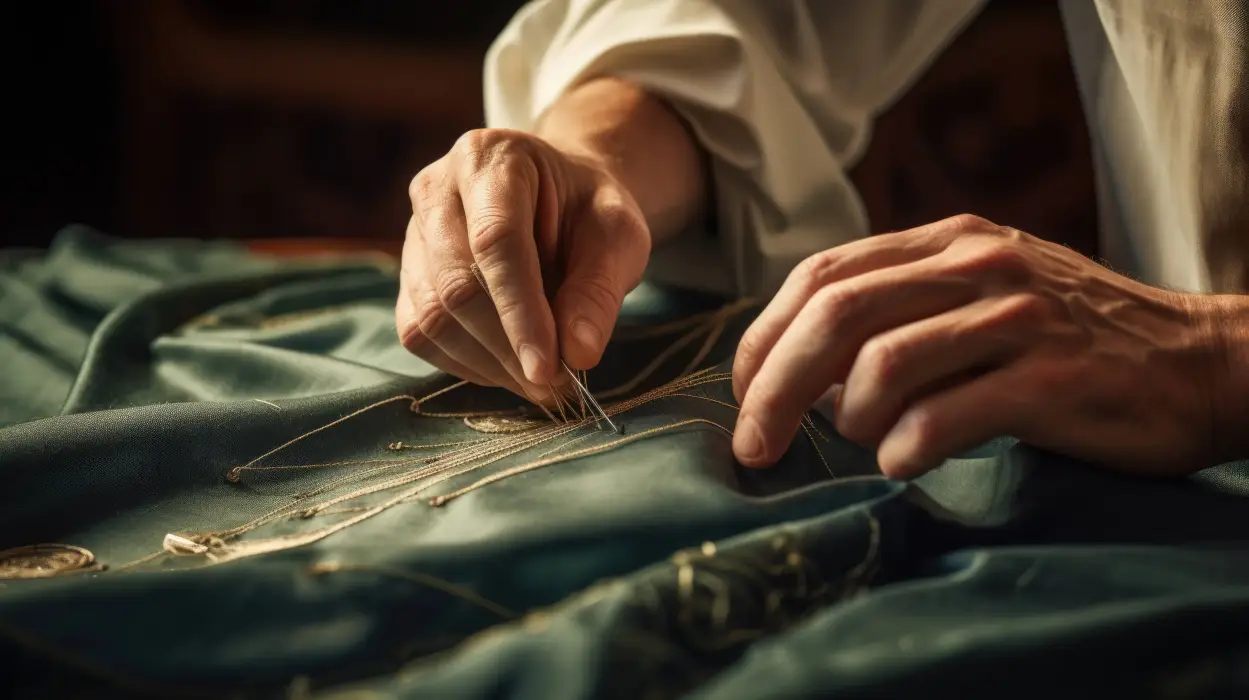A handicraft, sometimes more precisely expressed as artisanal handicraft or handmade, is any of a wide variety of types of work where useful and decorative objects are made completely by one’s hand or by using only simple, non-automated related tools like scissors, carving implements, or hooks. It is a traditional main sector of craft making and applies to a wide range of creative and design activities that are related to making things with one’s hands and skill, including work with textiles, moldable and rigid materials, paper, plant fibers, clay, etc. One of the oldest handicrafts is Dhokra; this is a sort of metal casting that has been used in India for over 4,000 years and is still used. In Iranian Baluchistan, women still make red ware hand-made pottery with dotted ornaments, much similar to the 5,000-year-old pottery tradition of Kalpurgan, an archaeological site near the village. Usually, the term is applied to traditional techniques of creating items (whether for personal use or as products) that are both practical and aesthetic. Handicraft industries are those that produce things with hands to meet the needs of the people in their locality without using machines.
Collective terms for handicrafts include artisan, crafting, and handcrafting. The term arts and crafts is also applied, especially in the United States and mostly to hobbyists’ and children’s output rather than items crafted for daily use, but this distinction is not formal, and the term is easily confused with the Arts and Crafts design movement, which is in fact as practical as it is aesthetic.
Handicraft has its roots in the rural crafts—the material-goods necessities—of ancient civilizations and many specific crafts have been practiced for centuries, while others are modern inventions or popularizations of crafts which were originally practiced in a limited geographic area.
Many handcrafters use natural, even entirely indigenous, materials while others may prefer modern, non-traditional materials, and even up cycle industrial materials. The individual artisanship of a handcrafted item is the paramount criterion; those made by mass production or machines are not handicraft goods.
Seen as developing the skills and creative interests of students, generally and sometimes towards a particular craft or trade, handicrafts are often integrated into educational systems, both informally and formally. Most crafts require the development of skill and the application of patience but can be learned by virtually anyone.
Like folk art, handicraft output often has cultural and/or religious significance, and increasingly may have a political message as well, as in craftivism. Many crafts become very popular for brief periods of time, spreading rapidly among the crafting population as everyone emulates the first examples, then their popularity wanes until a later resurgence.
Handicraft, often regarded as the art of creating goods by hand with skill and imagination, stands as a testament to human creativity and ingenuity. Rooted in tradition and shaped by cultural heritage, handicraft embodies the essence of craftsmanship, inviting us to explore the intersection of artistry and functionality. From ancient civilizations to modern artisans, the practice of handicraft has left an indelible mark on societies around the world, enriching lives and preserving traditions for generations to come.
Handicraft is a celebration of individuality and authenticity. Unlike mass-produced goods churned out by machines, handicraft items bear the unique imprint of their creators. Each stitch, brushstroke, or chisel mark tells a story, reflecting the skill, passion, and personal touch of the artisan. Whether it’s a hand-woven textile, a meticulously carved sculpture, or a delicately painted pottery piece, handicraft items possess a soulful quality that transcends their material form.
Handicraft serves as a bridge between past and present, connecting us to our cultural roots and heritage. Across different civilizations and epochs, artisans have passed down traditional techniques and craftsmanship from one generation to the next, preserving time-honored practices that might otherwise fade into obscurity. In doing so, handicraft not only honors the legacy of our ancestors but also fosters a sense of continuity and belonging in an ever-changing world.
Handicraft embodies sustainability and environmental consciousness in an age of mass consumption and disposable culture. Unlike factory-produced goods that often contribute to pollution and waste, handicraft emphasizes the use of natural materials, renewable resources, and eco-friendly practices. Artisans prioritize quality over quantity, creating durable and long-lasting products that stand the test of time. By supporting local artisans and embracing handmade goods, consumers can reduce their carbon footprint and support sustainable livelihoods within their communities.
Beyond its practical utility, handicraft serves as a form of self-expression and creative exploration. For artisans, the act of crafting is a deeply fulfilling endeavor, allowing them to channel their imagination and skills into tangible works of art. Whether it’s a form of relaxation, meditation, or cultural expression, handicraft offers a therapeutic outlet for self-discovery and personal growth. Moreover, the process of creating handmade goods fosters a sense of pride and accomplishment, empowering artisans to share their talents with the world.
In today’s digital age, where technology reigns supreme, the resurgence of handicraft represents a nostalgic yearning for authenticity and human connection. In a world dominated by screens and algorithms, handmade goods offer a welcome respite from the digital noise, inviting us to slow down, appreciate the beauty of imperfection, and reconnect with the tangible world around us. Whether it’s a hand-knitted sweater, a hand-painted mural, or a handcrafted piece of furniture, the allure of handicraft lies in its ability to evoke emotion, inspire wonder, and spark joy in our everyday lives.
Handicraft embodies the timeless values of creativity, tradition, and sustainability. As we navigate an increasingly fast-paced and digitized world, the practice of handicraft serves as a beacon of authenticity, reminding us of the beauty and richness of human craftsmanship. Whether it’s preserving cultural heritage, fostering environmental stewardship, or nurturing personal creativity, handicraft continues to captivate hearts and minds, leaving an enduring legacy for future generations to cherish and admire.
(Collected)





